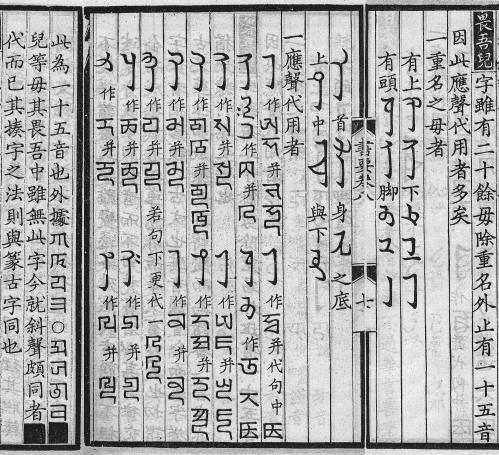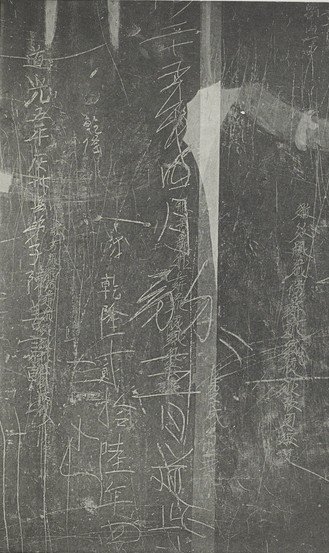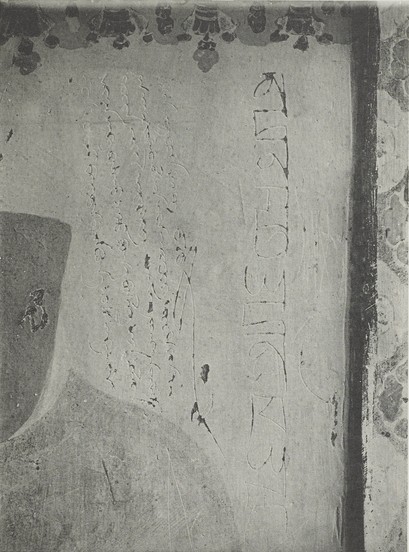BabelStone Blog
Friday, 4 November 2011
Phags-pa Graffiti
[This is a revised version of a blog post that I first published on 12 May 2007, but which I later deleted.]
The Caves of the Thousand Buddhas 千佛洞 near the ancient Silk Road town of Dunhuang 敦煌 are world famous for their beautiful Buddhist murals, dating from the 4th through the 14th centuries. And like many such places, visitors over the centuries have taken delight in defacing them with senseless graffiti in many scripts and languages :
Chinese and Tangut Graffiti in Dunhuang Cave 196 (Pelliot #63)
Source : Les grottes de Touen-Houang vol.6 p.97
In the above image from Cave 196 (Pelliot #63) Tangut Buddhist grafitti relating to the bodhisattva Samantabhadra (普賢菩薩) inscribed on the walls of this late Tang cave are over-inscribed with grafitti in Chinese dated Daoguang 5 [1825] (on the left) and Qianlong 26 [1761] (in the middle).
What interests me most of all is an inscription in Cave 217 (Pelliot #70)> in the Phags-pa script (I am not sure if the inscription still survives, as it is not visible in modern photographs of the cave art) :
Phags-pa Inscription in Dunhuang Cave 217 (Pelliot #70)
Source : Les grottes de Touen-Houang vol.6 p.99
The murals in this cave are believed to date to the early High Tang (circa 725), so the Phags-pa inscription cannot be original (the script was not invented until the mid 13th century). Indeed it is very roughly inscribed onto the face of the mural, and is evidently an example of 13th or 14th century graffiti. The inscription itself is very clear, and reads mėn bu yėn qa yė ꡏꡦꡋ ꡎꡟ ꡗꡦꡋ ꡢ ꡗꡦ :

The language of this inscription is Uyghur, and although we know that the Phags-pa script was intended for use in writing the Uyghur language (see further below), this is one of the very few surviving examples of Uyghur written in the Phags-pa script.
| Phags-pa | Transliteration | Old Uyghur | Meaning |
|---|---|---|---|
| ꡏꡦꡋ | mėn | ᠮᠡᠨ | Uyghur men "I" |
| ꡎꡟ ꡗꡦꡋ | bu yėn | ᠪᠤᠶᠠᠨ | Uyghur buyan "act or merit" (from Sanskrit puṇya) |
| ꡢ ꡗꡦ | qa yė | ᠬᠠᠶᠠ | Uyghur qaya "rock" |
The use of the Phags-pa letter ė in the back-vowel words buyan and qaya is unexpected, but perhaps indicates that a was fronted to ä after y in the Uyghur dialect of Buyan Qaya.
Buyan Qaya, literally "Rock of Merit", is a Buddhist personal name, and I read somewhere (but I can no longer find the source) that the longer inscription in Old Uyghur script to the left of the Phags-pa inscription records that this Buyan Qaya came to Dunhuang from Suzhou (in Gansu) three years previously. The same name is attested elsewhere, for example in a Uyghur legal document witnessed: "This mark (is that of) me, witness, Buyan Qaya" (see L. Ligeti (ed.), Studia Turcica in Bibliotheca Orientalis Hungarica XVII (Budapest, 1971) page 497). This wording echoes the words "I, Buyan Qaya" inscribed in Phags-pa script on the cave wall, and could suggest that Buyan Qaya wrote these words in witness of a legal contract or religious vow at the caves. However, I prefer to imagine that he scratched the words "I, Buyan Qaya" on the wall next to to the figure of an official (or so it seems from the limited view of the painting shown by Pelliot) in the existing Tang dynasty mural, as if to say, "Look, this is a picture of me, Buyan Qaya!"; then afterwards, on the left, he wrote the longer explanation in Old Uyghur script (which is beyond my skills to read).
How to Write Uyghur in Phags-pa Script
In his work on calligraphy, Shūshǐ Huìyào 書史會要, the 14th century author Tao Zongyi 陶宗儀 gives a description of the Old Uyghur script in which he uses Phags-pa letters to describe the pronunciation of the letters of the Uyghur script :

Tao Zongyi 陶宗儀, Shūshǐ Huìyào 書史會要 vol. 8 folio 7a–8a
| Uyghur Letter | Phags-pa Letters | Phags-pa Transliteration | Notes |
|---|---|---|---|
| ᠠ | ꡝ ꡠ ꡜ ꡜꡦ | A and E HA and HĖ | As the Phags-pa letter Ė cannot occur initially, initial Uyghur e is represented by the Phags-pa letter E (which is apparently not used medially or finally in writing Uyghur). |
| ᠸ | ꡤ ꡓ | FA (initial) W (medial) | |
| ᠬ | ꡢ ꡖ | QA ·A | |
| ᠤ | ꡟ ꡡ ꡓ | U and O W | |
| ᠰ | ꡛ ꡛꡦ | SA and SĖ | |
| ᠵ | ꡗ ꡗꡦ ꡆ ꡆꡦ | YA and YĖ JA and JĖ | This letter should also represent the vowel i. |
| ᠺ | ꡂ ꡂꡦ ꡁ ꡁꡦ | GA and GĖ KHA and KHĖ | |
| ᠲ | ꡊ ꡊꡦ ꡉ ꡉꡦ | DA and DĖ THA and THĖ | |
| ᠮ | ꡏ ꡏꡦ | MA and MĖ | |
| ᠨ | ꡋ ꡋꡦ | NA and NĖ | |
| ᠪ | ꡎ ꡎꡦ ꡖ ꡖꡦ | BA and BĖ (initial and medial) ·A and ·Ė (final) | |
| ᠴ | ꡅ ꡅꡦ | CHA and CHĖ | |
| ᠱ | ꡚ ꡚꡦ | SHA and SHĖ | |
| ᠷ | ꡘ ꡘꡦ | RA and RĖ | |
| ᠯ | ꡙ ꡙꡦ | LA and LĖ |
Index of BabelStone Blog Posts

